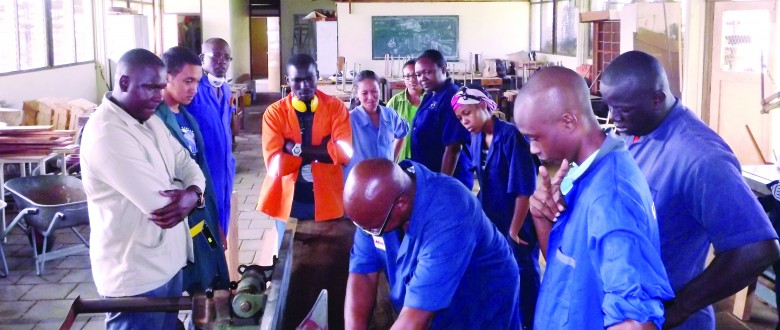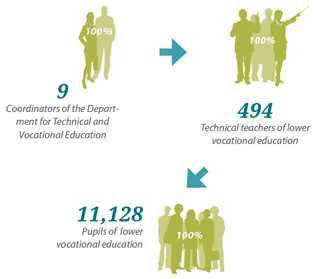
As the coordinator for the Construction sector at the Suriname Ministry of Education, Ms. Kariem approached representatives of the woodworking industry and offered them the opportunity to train teachers of lower vocational education institutions. This is her story.
Teachers learning
 Ms. Laila Kariem (right) is one of nine coordinators at the Department for Technical and Vocational Education in Suriname. VVOB organises workshops, study visits and coaching for these coordinators to develop the capacity of the overarching Ministry of Education.
Ms. Laila Kariem (right) is one of nine coordinators at the Department for Technical and Vocational Education in Suriname. VVOB organises workshops, study visits and coaching for these coordinators to develop the capacity of the overarching Ministry of Education.
As a result of these capacity-building efforts, the coordinators at the Department have started to take action on their own initiative – including Ms. Kariem. “I was motivated to have a deep conversation with the management of our department”, she begins. “I wrote a project proposal – something I had learned from the VVOB training ‘How to write a project proposal’ – and contacted the Chamber of Commerce and Industry as well as the representatives of woodworking companies.”
She offered the woodworking industry the opportunity to provide trainings in blackboard sketching, bench carpentry and mechanical woodwork to 24 teachers of lower vocational education institutions: “We received wood for the trainings from the timber companies, while the Chamber of Commerce and Industry provided us with wood glue”, she elaborates.
Together with the trainers from the companies, Ms. Kariem determined the content of the training activities: “Next to technical skills, the vocational teachers also learnt how to effectively manage their classrooms.”
Continue collaboration
The trainings were a big success, says not only Ms. Kariem, but also the trainers: “Attendance was high and everyone was enthusiastic; these trainings are a must for all teachers!”
Indeed, the participating Building and Construction teachers highly appreciated this initiative as a refresher course: “It was a good decision to include blackboard sketching in the training”, a teacher recalls. “The students receive sketching lessons during their theoretical classes, but as teachers of practical classes, we tend to neglect sketching as an important part of the curriculum.”
Another teacher highlights the importance of these trainings for his students’ motivation: “We often used woodwork machines during the training. We have purchased machines for the students to work with at school. I notice that when we use them in class, students are more interested.” He hopes to benefit more from these types of trainings: “We have to continue this collaboration between the industry and the education department so that the learning process of both teachers and their students can improve.”
 Closing the gap
Closing the gap
Inspired by this first success in the area of woodwork, Ms. Kariem has moved on to contacting Surinamese companies for a next training course on painting techniques. Hopefully, all teachers in the lower vocation education system can be reached: “If this approach is extended in a sustainable way, teachers of all fields will be able to teach their subjects in a better way.”
Also, as these two sectors work more closely together, the gap between education and the world of labour will become smaller: “Youngsters will be better prepared to work at a company, which is to the benefit of both the youngsters and the company. That is why I can say I am proud of what I have accomplished.”




